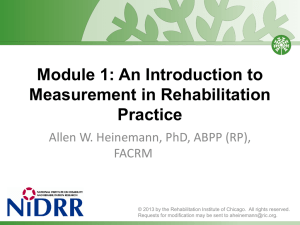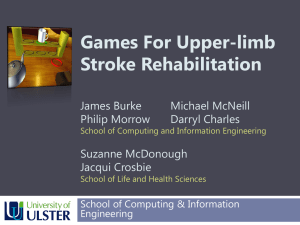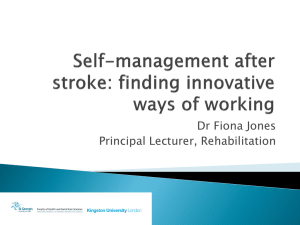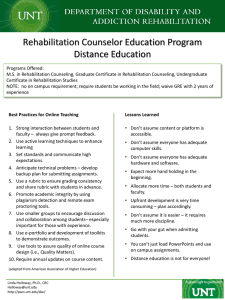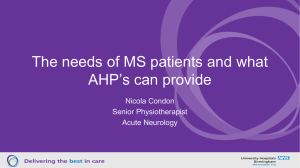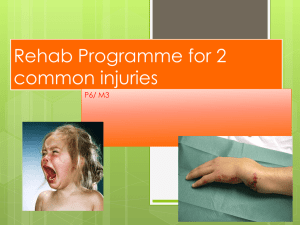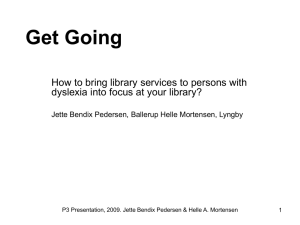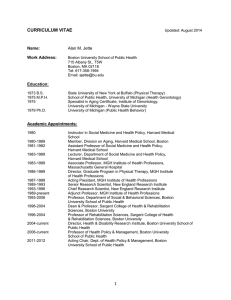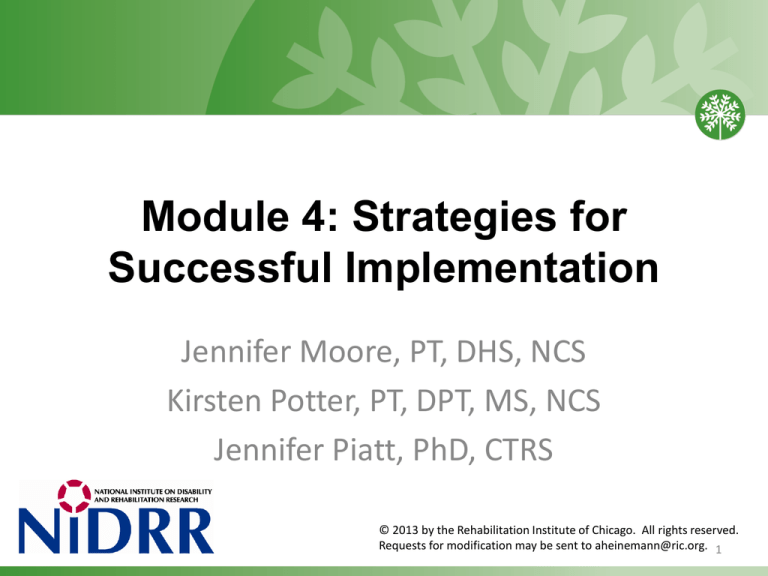
Module 4: Strategies for
Successful Implementation
Jennifer Moore, PT, DHS, NCS
Kirsten Potter, PT, DPT, MS, NCS
Jennifer Piatt, PhD, CTRS
© 2013 by the Rehabilitation Institute of Chicago. All rights reserved.
Requests for modification may be sent to aheinemann@ric.org. 1
Module 4: Objectives
•
•
•
•
•
Describe the need for outcomes planning
Describe the benefits and challenges with using outcome
measures in clinical practice
Identify strategies to facilitate the use of outcome measures in
clinical practice.
Identify strategies to overcome challenges to implementing
outcome measurement in clinical practice.
Effectively sustain outcome measurement use across his or her
practice, and across practice sites or programs.
2
Benefits of Outcome Measures:
Clinicians and Patients
• Recommended for use in various clinical guidelines, and implementation leads to
improved patient outcomes and satisfaction
• Identifies and quantifies impairment, activity limitations, participation restrictions and
personal factors
• Assists in clinical-decision making
–
–
–
–
Helps determine whether treatment plan is appropriate
Identifies whether patient is making meaningful progress
Determines whether patient is at risk for falls, impairment levels, prognosis, etc
Diagnosis and referrals
•
Enhances communication between clinicians, referral sources and insurance companies
•
Engages and motivates patients
(Bekkering et al, 2005; Duncan et al, 2002; Reker et al, 2002, 3
Swinkels 2011, Jette 2009, Finch 2002, Kay 2001)
Benefits of Outcome Measures:
Organizations
•
Increases accountability
– Provides mechanism to compare clinician outcomes
•
Improves efficiency of clinicians
•
Improves care and outcomes of clinical care
(Swinkels 2011, Jette 2009, Finch 2002, Kay 2001)
4
The need for outcomes planning
•
Policy
– Centers for Medicare & Medicaid Services
– Commission on the Accreditation of Rehabilitation Facilities (CARF)
– Affordable Care Act of 2010
•
Client/patient: Feedback on progress identified by standardized
measures improves outcomes
– Individuals that received daily reinforcement of speed had greater walking speed
at discharge than those that didn’t receive reinforcement (Dobkin et al, 2010)
– Individuals who received enhanced medical rehabilitation showed higher intensity
therapy, more engagement in therapy sessions, improved gait speed, and 6 min
walk distance when compared to those who received standard rehabilitation
(Lenze et al , 2012)
5
Clinical Utilization of
Standardized Instruments
• 52% of Physical Therapists reported not using standardized measurements,
49% of these indicated no future plans to use standardized assessments
• Mental health practitioners utilize their own intuition more than standardized
measures to monitor progress
• Oncologists rely more on their own impressions and informal assessments to
make decisions
• Nurses rely on clinical judgment to manage patients
(Jette et al, 2009; Garland et al, 2003;
Taylor et al, 1996; Meadow et al, 1998)
6
Common Facilitators
Individual
• Positive attitude: to measurement and change, convinced of benefits
• Flexibility: room for personal considerations
• Practicality: immediacy, negotiate with insurers, quality improvement
External
• Access to resources: range of measures, guide to selection
– Provide summaries of research written in an understandable manner (Bury, 1996)
– Concisely summarized research (Jette et al, 2003)
– Free online resources that are available at the point of care (Jette et al, 2003)
• Support: from colleagues (opinion leaders) and organization
• Guidance in selection, administration, scoring, and interpretation
(Swinkels 2011, Jette 2009, Finch 2002, Kay 2001)
7
Common Challenges
• Individual
– Time: to search, administer, score, interpret
– Knowledge: to select, interpret
– Resources too few available, too many to choose, difficult to set up,
equipment required, unclear instructions, difficult to interpret
– Competence: education, routine, experience
– Attitude: resist change/set in ways, skeptical, overwhelmed,
confidence
– Opinion leader (vs. champion)
•
Organizational
– Time and Cost: investment required, no compensation
– Policy: no policy, poor adherence/compliance
– Culture: congruence/conflict at micro and macro levels
(Swinkels 2011, Jette 2009, Finch 2002, Kay 2001)
8
Discuss Solutions to
Clinical Challenges
• Documentation
•
•
– Advocate for clinical useful, important measures to be a part of your electronic
medical records at your institution.
– Available test packets
– Create “cheat sheets” with meaningful change scores
Equipment
– Designated testing areas for testing
– Testing kits for common instruments
– Have clinical students make testing kits
Time to administer
– Instrument checklists for each patient
– Integrate clinically useful assessments into the treatment process (for
example, the kitchen test of the EFPT)
9
Discuss Solutions to
Clinical Barriers
•
Training & Service Delivery
– Develop in-services about potential measures that will address the needs of
the populations you serve at your facility
– Have staff share assessments that they’ve learned about at workshops that
could benefit the team
– Look for public domain instruments that can be used without cost
– Share outcome measure data at team meetings
– Read articles about different measures and what they could contribute to
practice strategies
– Start a journal club or brown bag outcome meeting
– Work with your quality assurance staffing to relate your data back to those
being reported by the entire facility or for accreditation purposes.
– Share data between disciplines so there is not unnecessary duplication of
testing, and that outcome results can be used across the team
10
Databases and Resources
11
Outcome Measurement Resources
•
Rehabilitation Measures Database:
•
APTA Neurology Section EDGE recommendations
– www.rehabmeasures.org
– ~200 instrument summaries of psychometric properties and clinical utility
– Includes a link to the testing document whenever possible
– www.neuropt.org/professional-resources/neurology-section-outcome-measuresrecommendations
– Review of instruments used in physical therapy that assess patients with Stroke,
MS, TBI, SCI (PD and vestibular to come this year)
– Recommendations instruments to be used in clinical practice
Outcome Measurement Resources
•
Stroke Engine Assess
•
Center for Outcome Measurement in Brain Injury
– strokengine.ca/assess/
– Psychometrics and clinical utility information about instruments that can be used
with individuals with stroke
– Provides instrument whenever possible
–
–
–
–
www.tbims.org/combi/
~30 instrument reviews of psychometrics and clinical utility
Specific to measuring individuals with brain injury
Links to instrument whenever possible
Outcome Measurement Resources
•
Acquired Brain Injury Evidence Based Review
•
Evidence-based Review of Stroke Rehabilitation
–
–
–
–
–
–
–
–
www.abiebr.com
Educational modules and case studies on evidence-based practice in brain injury
Includes chapter on psychometrics and clinical utility of instruments
Specific to individuals with brain injury
www.ebrsr.com
Educational modules and case studies on evidence-based practice in stroke
Includes chapter on psychometrics and clinical utility of instruments
Specific to individuals with stroke
Outcome Measurement Resources
•
Orthopedic Scores
•
•
•
•
•
http://www.orthopaedicscore.com/
Measures that assess musculoskeletal conditions
No psychometric information, Minimal information about score interpretatio
Can score directly on test forms on website, website scores and produces
completed test document
Physiopedia
–
–
–
–
http://www.physio-pedia.com/Outcome_Measures
Measures that assess musculoskeletal, neuro and common geriatric conditions
Psychometrics, clinical utility
Some videos to demonstrate test administration
15
Outcome Measurement Resources
•
Spinal Cord Injury Rehabilitation Evidence
•
Other website descriptions with links available at the
Rehabilitation Measures Database at
–
–
–
–
www.scireproject.com
Educational modules and case studies on evidence-based practice in stroke
Includes chapter on psychometrics and clinical utility of instruments
Specific to individuals with spinal cord injury
www.rehabmeasures.org/rehabweb/links.aspx
Classroom Activities
17
Overview of Classroom Activities
1)
Discussion of need for standardized instruments
2)
Develop a presentation on measurement
3)
Adapting an evidence-based summary to meet your clinical
needs
4)
Develop a resource binder
5)
Discuss responses to common reaction to measurement
utilization.
18
Classroom Activity (1)
• Activity: Discuss the need for outcomes at each of these levels:
– Patient
Improvement in outcomes across ICF levels (body structure & function, activity,
participation)
Length of stay
Satisfaction
Other?
– Clinician
Changes in decision-making
Efficiency and Effectiveness
Satisfaction
Other?
– Organizational or process level
Overall patient outcomes
Reimbursement
Planning Discharge
Other?
19
Classroom Activity (2)
• Activity: Develop a presentation with your classmates that you could
share at your clinical site or with your clinical instructor
–
–
–
–
How to use an outcome measure
The fundamentals of measurement – reliability, validity, indices of change, etc
A case description in which measurement was used
Include a list of resources that you could share at your clinical site.
20
Classroom Activity (3)
• Activity: Adapt a summary from a free online website to meet your
needs
– Download content from the website
– Adapt with clinically relevant information (examples in next few slides)
– Save to share examples on your clinical
21
22
Include information relevant to your clinic:
•Similar patient populations
•Brief review of psychometrics
•Indices of change
•Considerations for use at your clinics (recommended in Outpatient vs.
inpatient, etc)
23
Add site specific information:
•Where is the equipment kept?
•Specific area “marked” for 10 meter walk
•When and how often will the measure be taken?
•Recommendations for using in goals
•Where and how is the instrument documented in the POC?
•How are the results transferred to the next level of care?
24
Classroom Activity (4)
• Activity: Develop resource binders
–
–
–
–
Copies of relevant outcome measures
Scoring sheets
List of website resources
One-page summaries of most pertinent information
Indications for use
Administration and scoring procedures
Interpretation information/data
– Normative data
– Responsiveness values
25
Describe how you would respond to
the following comments
•
•
•
•
•
We don’t have time to collect outcome measures!
Nobody requires us to collect this information!
Measurement is unnecessary!
I want to spend my time treating patients, not measuring patients.
I already know how to bill using G codes.
26
Overall Discussion of the Course
Now that you’ve completed this course, use the following discussion
questions to reflect on your learning across the four modules:
1.
2.
3.
4.
5.
6.
What is the value of using the ICF to organize your clinical
measures?
Why is it critical to use a client-centered approach?
Why should you use valid and reliable measures?
How can you interpret change and know that the patient has
made a meaningful improvement?
What strategies could you use to introduce measures into your
practice?
What can you do to overcome barriers you will find in developing
an outcome measurement plan in your clinical site?
27
Questions and
Discussion
28
Project Staff
• Allen Heinemann, PhD – Director of CROR, at Rehabilitation Institute of Chicago,
•
•
•
•
•
•
Northwestern University PM&R
Joy Hammel, PhD, OTR/L, FAOTA – Professor, Occupational Therapy and Disability
Studies, University of Illinois at Chicago
Carolyn M. Baum, PhD, OTR/L, FAOTA – Professor, Occupational Therapy, Neurology
and Social Work, Washington University School of Medicine
Jennifer Moore, PT, DHS, NCS – Clinical Practice Leader, Neurological Physical
Therapy, Rehabilitation Institute of Chicago
Jennifer Piatt, PhD, CTRS – Assistant Professor, Recreational Therapy, Public Health,
Indiana University
Kirsten Potter, PT, DPT, MS, NCS – Associate Professor, Physical Therapy, Rockhurst
University
Jillian Bateman, OTD/OTR/L, CCRC – Project Manager, CROR Rehabilitation Institute
of Chicago
29
Project Contributors
•
•
•
•
•
Anne Deutsch, PhD – Clinical Research Scientist, Rehabilitation Institute
of Chicago
Richard Gershon, PhD – Professor and Associate Chair, Medical and
Social Sciences, Northwestern University
Allan Kozlowski, PT, PhD – Clinical Research Scientist, Mt. Sinai School
of Medicine
Jason Raad, PhD – Project Manager, CROR, Rehabilitation Institute of
Chicago
Kathleen Stevens, PhD RN –Nursing Education, Rehabilitation Institute
of Chicago, Northwestern University PM&R
30
References
•
•
•
Bekkering GE, van Tulder MW, Hendriks EJ, Koopmanschap MA,
Knol DL, Bouter LM, Oostendorp RA. Implementation of clinical
guidelines on physical therapy for patients with low back pain:
randomized trial comparing patient outcomes after a standard and
active implementation strategy. Phys Ther 2005; 85(6):544-555.
Duncan PW, Horner RD, Reker DM, Samsa GP, Hoenig H,
Hamilton B, LaClair BJ, Dudley TK. Adherence to postacute
rehabilitation guidelines is associated with functional recovery in
stroke. Stroke 2002; 33(1):167-177.
Reker DM, Duncan PW, Horner RD, Hoenig H, Samsa GP,
Hamilton BB, Dudley TK. Postacute stroke guideline compliance
is associated with greater patient satisfaction. Arch Phys Med
Rehabil 2002; 83(6):750-756.
31
References
•
•
•
•
Swinkels RA, van Peppen RP, Wittink H, Custers JW, Beurskens
AJ. Current use and barriers and facilitators for implementation of
standardized measures in physical therapy in the Netherlands.
BMC Musculoskelet Disord 2011 May; 22; 12:106.
Jette DU, Halbert J, Iverson C, Miceli E, Shah P. Use of
standardized outcome measures in physical therapist practice:
perceptions and applications. Phys Ther 2009; 89:125-135.
Finch E, Brooks D, Stratford P, Mayo N. Physical rehabilitation
outcome measures. 2nd ed. Hamilton: BC Decker; 2002.
Kay T, Myers A, Huijbregts M. How far have we come since
1992? A comparative survey of physiotherapists' use of outcome
measures. Physiother Can 2001; 53(4):268-275.
32
References
•
•
Dobkin BH, Plummer-D’Amato P, Elashoff R, Lee J & SIRROWS
Group. International randomized clinical trial, stroke inpatient
rehabilitation with reinforcement of walking speed (SIRROWS),
improves outcomes. Neurorehabilitation and Neural Repair 2010;
24:235.
Lenze EJ, Host JJ, Hildebrand MW, Morrow-Howell N, Carpenter
B, Freedland KE, Baum CA, Dixon D, Core P, Wendleton L, &
Binder EF. Enhanced medical rehabilitation increases therapy
intensity and engagement and improves functional outcomes in
postacute rehabilitation of older adults: A randomized-controlled
trial. JAMDA 2012; 13:708-712.
33
References
•
•
•
Garland AF, Kruse M, Aarons GA. Clinicians and outcome
measurement: what's the use? J Behav Health Serv Res 2003
Oct-Dec; 30(4):393-405.
Taylor KM, Macdonald KG, Bezjak A, Ng P, DePetrillo AD.
Physicians' perspective on quality of life: an exploratory study of
oncologists. Qual Life Res 1996 Feb; 5(1):5-14.
Meadows KA, Rogers D, Greene T. Attitudes to the use of health
outcome questionnaires in the routine care of patients with
diabetes: a survey of general practitioners and practice nurses.
Br J Gen Pract 1998 September; 48(434):1555–1559.
34
Copyright Information
© 2013 by the Rehabilitation Institute of Chicago. This work is
licensed under a Creative Commons license at
http://creativecommons.org/licenses/by-ncnd/3.0/deed.en_US. You are free to copy, distribute, and transmit
the work, subject to the conditions listed in the license. For
permission to modify this work or to use it for commercial
purposes, please e-mail Allen Heinemann at
aheinemann@ric.org.
35
Help us improve…
Thank you for downloading the Outcomes Measurement Educational Modules. Please help us
enhance and improve this resource by completing our short (10 minute) survey:
https://www.surveymonkey.com/s/BZKCC3B
Thank you!


